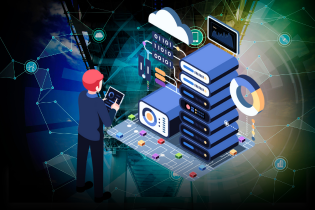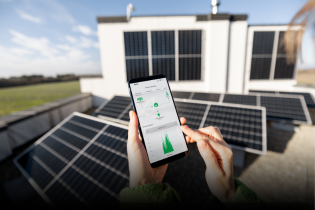The energy landscape is undergoing a dramatic transformation, with the rise of smart grids poised to revolutionize how we generate, transmit, and consume electricity. At the heart of this revolution lies the Internet of Things (IoT), enabling a paradigm shift from traditional, often inefficient grids to intelligent, responsive networks.

The Smart Grid Market: A Statista report reveals a burgeoning market, with the global smart grid market projected to reach a staggering $130 billion by 2028, growing at a remarkable annual rate of 17.4%. This rapid growth underscores the increasing adoption and demand for IoT-powered smart grid solutions.
Unlocking the Power of IoT in Modernizing Power Grids
Real-time Data Acquisition: IoT sensors, smart meters, and communication devices facilitate continuous and automated data collection across the grid, from generation to consumption. This real-time data stream empowers grid operators with critical insights into grid performance, enabling proactive responses and optimized operations.
Enhanced Grid Resilience and Reliability: By continuously monitoring critical parameters like voltage levels, frequency, and power quality, IoT-enabled systems can proactively identify and address potential issues before they escalate into major disruptions. This proactive approach significantly enhances grid reliability, minimizing outages and ensuring a continuous power supply.
Seamless Integration of Renewable Energy Sources: The integration of renewable energy sources like solar and wind power presents unique challenges due to their intermittent nature. IoT systems enable real-time monitoring and control of these sources, optimizing grid operations to accommodate fluctuating renewable energy generation.
Advanced Cybersecurity: As grids become increasingly interconnected, cybersecurity threats loom large. IoT solutions equipped with advanced security measures, such as intrusion detection systems, firewalls, and encryption, safeguard critical infrastructure from cyberattacks, ensuring the integrity and reliability of power delivery.
Key Components of IoT-Enabled Smart Grids
Smart Meters: These bi-directional communication devices enable real-time monitoring of energy consumption, facilitate demand-side management programs, and improve billing accuracy.
Grid Monitoring Systems: IoT sensors strategically placed across substations, transformers, and distribution lines collect data on voltage levels, frequency, and power quality, providing a comprehensive overview of grid health.

Distributed Energy Resources (DERs): IoT-enabled controllers and inverters seamlessly integrate renewable energy sources like solar panels and wind turbines into the grid, optimizing their contribution to the overall energy mix.
Energy Storage Systems: IoT enables intelligent management of energy storage systems, such as batteries, optimizing their utilization to balance supply and demand, improve grid stability, and enhance the integration of renewable energy sources.
Advanced Analytics and Machine Learning: IoT generates vast amounts of data. Advanced analytics and machine learning algorithms analyze this data to identify patterns, predict future grid behavior, optimize energy distribution, and proactively address potential issues.
Key Benefits Transforming Traditional Grids into Smart Networks
IoT empowers a transformative shift from traditional, reactive grids to intelligent, proactive networks:
Real-time Data-Driven Decision Making: Real-time data collection and analysis enable grid operators to make informed decisions, optimize grid operations, and respond swiftly to any disturbances.
Improved Grid Stability and Reliability: Proactive identification and mitigation of potential issues significantly enhance grid stability and reduce the frequency and duration of power outages.
Enhanced Integration of Renewable Energy Sources: IoT facilitates seamless integration of renewable energy sources, maximizing their contribution to the grid while maintaining stability.
Enhanced Grid Security: Advanced cybersecurity measures protect critical infrastructure from cyberattacks, ensuring the continued and reliable delivery of electricity.
Improved Energy Efficiency: By optimizing energy distribution and demand-side management, IoT contributes to improved energy efficiency and reduced energy consumption.
Enhanced Customer Experience: Improved reliability, enhanced customer service, and greater control over energy consumption contribute to an enhanced customer experience.
The Future of Smart Grids: A Vision of the Future
As IoT technology continues to evolve, so too will its impact on smart grids. We can expect to see further advancements in:
Artificial Intelligence (AI) and Machine Learning: AI-powered algorithms will play an increasingly crucial role in predicting grid behavior, optimizing operations, and enhancing grid resilience.

Edge Computing: Processing data closer to the source will enable faster response times and improved decision-making.
Blockchain Technology: Blockchain can enhance grid security and transparency, ensuring the integrity of energy transactions.
Advanced Communication Technologies: 5G and beyond will enable faster and more reliable communication between grid components, further enhancing grid performance.
Conclusion:
The transformation of traditional power grids into intelligent, IoT-powered networks is crucial for a sustainable and reliable energy future. FSM Connect empowers this transformation with cutting-edge IoT solutions that enable real-time data collection, advanced analytics, and seamless grid management.
By leveraging our expertise, you can harness the power of IoT to build a smarter, more resilient, and more sustainable energy future. Contact us today to explore how FSM Connect can help you achieve your smart grid objectives.


